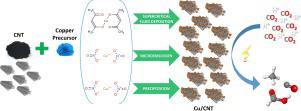The Journal of Supercritical Fluids ( IF 3.9 ) Pub Date : 2020-07-30 , DOI: 10.1016/j.supflu.2020.104999 Carlos Jiménez , Jesús García , Fabiola Martínez , Rafael Camarillo , Jesusa Rincón

|
One of the most promising technologies for the mitigation of CO2 emissions involves its electrocatalytic reduction to valuable products. However, the development of effective catalysts is still a challenge. In this work, three different techniques have been compared for the synthesis of catalysts involving Cu-based nanoparticles deposited on carbon nanotubes (Cu/CNT): precipitation, microemulsion and supercritical fluid deposition (SFD). According to XRD, SFD allows obtaining mainly copper nanoparticles, while copper oxides are obtained by precipitation. Crystallite size of predominant Cu species of catalysts are between 7 (microemulsion) and 16 nm (SFD). The use of these catalysts in the electrochemical reduction of CO2 in gas phase produce carbon monoxide as main CO2 reduction product, followed by formic acid and methane. The catalyst obtained by microemulsion exhibited poor reproducibility. The catalyst synthesized by SFD achieved the largest CO2 conversion rate, a 30 % higher than that obtained with the one synthesized by precipitation.
中文翻译:

在CNT上沉积铜以合成用于电化学还原CO2的电催化剂:超临界流体沉积技术的优势
减轻CO 2排放的最有前途的技术之一涉及将其电催化还原为有价值的产品。但是,开发有效的催化剂仍然是一个挑战。在这项工作中,已经比较了三种不同的技术来合成涉及沉积在碳纳米管(Cu / CNT)上的基于铜的纳米粒子的催化剂:沉淀,微乳液和超临界流体沉积(SFD)。根据XRD,SFD允许主要获得铜纳米颗粒,而氧化铜通过沉淀获得。催化剂中主要的铜种类的微晶尺寸在7(微乳液)和16 nm(SFD)之间。在气相中电化学还原CO 2时使用这些催化剂可产生一氧化碳作为主要的CO 2还原产物,然后是甲酸和甲烷。通过微乳液获得的催化剂表现出差的再现性。通过SFD合成的催化剂实现了最大的CO 2转化率,比用沉淀法合成的催化剂高30%。



























 京公网安备 11010802027423号
京公网安备 11010802027423号